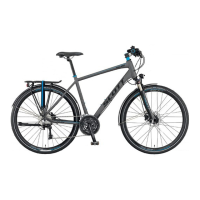52 53
TREKKING-PEDELEC | ORIGINAL OPERATING INSTRUCTIONS 2016 ORIGINAL OPERATING INSTRUCTIONS 2016 | TREKKING-PEDELEC
ENGLISH
ENGLISH
Note in general that the suspension fork must give in a little even when you
are just sitting on the bike (c) – this is the so-called negative suspension travel
or sag. When the front wheel passes through a depression in the ground, the
spring extends and the suspension fork will smooth out the uneven surface. If
the air pressure or the spring preload is too high, this effect is lost because the
suspension fork is already fully extended. This means that an important comfort
and safety factor is lost if the tyre briefly loses contact with the ground.
The suspension fork should yield by 10-20 % of the maximum suspension travel.
To measure the travel you can use the rubber ring (d) mainly located on the
thinner, plunging tube of the suspension fork. If there is no rubber ring, tie up
a cable tie around one of the stanchion tubes. Make sure it is not too tight, you
should still be able to move it, it should however not slip by itself.
Put on your usual riding clothing (including if necessary a packed rucksack),
sit on your bike and bring yourself into the usual riding position. Lean against a
fixed object (railings, wall etc.) and make sure you do not fall over. Ask a helper
to move the rubber ring or the cable tie downwards against the dust seal at the
lower leg.
Get off your SCOTT bike so that the fork does not compress any more. The dis-
tance between the rubber ring/cable tie and the wiper is the negative suspen-
sion travel, or sag (e). Compare it with the total suspension travel (as specified
by the manufacturer) to determine whether the suspension should be set to be
harder or softer.
With pneumatic suspension forks the spring rate is set by the air pressure in
the fork. The pressure must be set before the first ride by means of a special
high-pressure pump with pressure gauge (f) and modified later as required due
to changes in the weight of the rider and/or load.
Note the appropriate setting values and check them subsequently at regular
intervals. Always follow the recommendations of the manufacturer and never
exceed the maximum air pressure for the suspension fork. Always make a test
ride after each change to the settings.
Rebound damping
In most cases a red adjusting knob. (a)
The damping which controls the rate at which the forks extend after being com-
pressed. Prevents bike bobbing.
Lockout (b)
In most cases a lever on the suspension element or the handlebars.
A device to block the fork so that the suspension element does not cause bob
when riding on tarred roads or smooth surfaces. Not to be used off road.
FRONT SUSPENSION
Most of the SCOTT city, trekking bikes and SCOTT pedelecs have suspension
forks. This feature gives you better control of your SCOTT bike when riding
cross-country or on rough road surfaces and ensures more ground contact for
the tyre. It noticeably reduces the strain on you and your bicycle caused by the
mechanical shocks from the terrain.
Suspension forks differ in their types of spring elements and damping. Suspen-
sion forks normally work with air spring elements or less often with coil springs.
Damping is usually done by oil.
NOTE!
I
Suspension fork manufacturers normally include instructions with their
deliveries. Read them carefully before changing any settings or doing any
maintenance work on your suspension fork. You can find the instruction of the
suspension fork manufacturer on this SCOTT info CD.
NOTE!
I
For more information see the suspension glossary heading this chapter.
Adjusting the spring rate
To work perfectly, the suspension fork has to be adjusted to the weight of the
rider, the sitting posture and the intended use. Be sure to have this adjustment
carried out by your SCOTT dealer at the time of delivery.
b ca e fd

